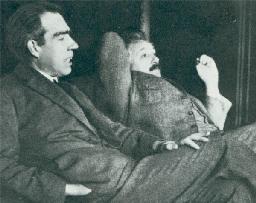 Bohr and Einstein
Bohr and Einsteinhome
Interpretations of QM and their inter-relation
An (incomplete) list of interpretations of quantum mechanics contains
- Copenhagen interpretation
- Statistical or ensemble interpretation
- de Broglie-Bohm pilot wave model(s)
- Relative state interpretation (and closely related: many world and many mind interpretation)
- Consistent (or decoherent) histories
- Modal interpretation
- Spontaneous collapse model(s)
- Transactional interpretation (Cramer 1986, 1987).
- Relational quantum mechanics (Rovelli, see e.g. here)
What one would really like to have is a neat classification of the different interpretations or even a unified treatment which illuminates the various relations between them. In what follows i have collected and annotated a few papers on that topic.
- Bub and Clifton
A elegant account of the relation between different interpretations/solutions to the measurement problem can be found in Bub and Clifton (1996) and Bub et al. (1999). They reconstruct the different attempts to solve the measurement problem as the quest to construct a maximal sublattice to which truth values can be assigned without violating the functional relationship constraint due to Kochen-Specker. They characterize these maximal sets by a preferred observable, R, which takes determinate values (note, that the propositions associated with a single observable generate a Boolean lattice). This work allows to categorize different variants of the modal interpretation, the de Broglie-Bohm and Bohr's complementarity interpretation (in the Bub-Clifton reading) in a unified manner: they differ only in the choice of this preferred observable. Bohm uses the position to have an always determinate value. In contrast, Bohr's choice depends on the 'means of observation' and is not fixed from the outset.
- James Hartle
In "What Connects Different Interpretations of Quantum Mechanics?" James Hartle investigates the relation between the consistent (or decoherent) history approach and other interpretations, like Bohr's or Bohm's. He claims that these can be viewed as special cases, i.e. restrictions to specific "histories".
- N.P.Landsman
In "When champions meet: Rethinking the Bohr-Einstein debate", Landman tries to relate some of Bohr's and Einstein's doctrines. He argues, that both were realists of some sort, i.e. concerned with the notion of "objectification". To Einstein this was related to spatial separability, while Bohr insisted on his infamous doctrine of classical concepts. Landsman now makes the ingenious move to translate these conditions (or what he takes for them) into the language of algebraic quantum theory. Thanks to Raggio's theorem these two positions turn out to be mathematical equivalent. But, as Landsman remarks, "This is not to say that their - now joint - doctrine is necessarily consistent."